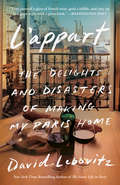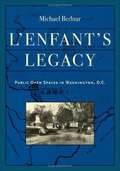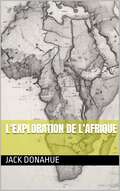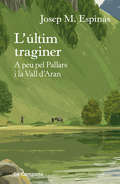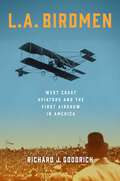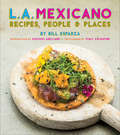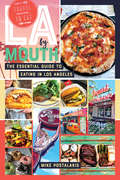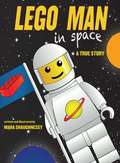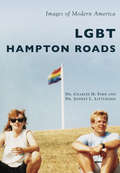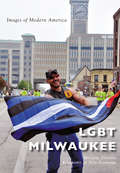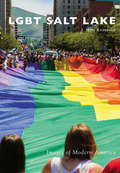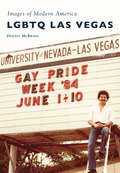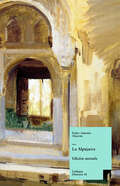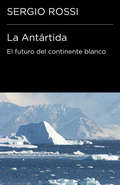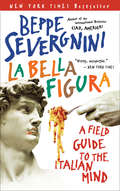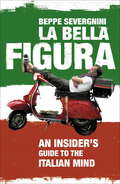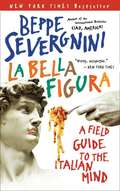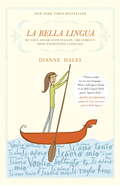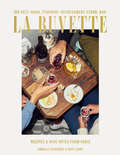- Table View
- List View
L'Amour Actually: Falling in Love in the Heart of France
by Melanie JonesAdvertising executive and city girl Melanie Jones decides to give up her old life in search of something simpler in South West France. After a series of adventures with skirt-ripping tractors, handsome twin farmers, and a bonkers ex-pat community, Melanie discovers that living France isn’t quite what she’d thought it would be.
L'Appart: The Delights and Disasters of Making My Paris Home
by David LebovitzBestselling author and world-renowned chef David Lebovitz continues to mine the rich subject of his evolving ex-Pat life in Paris, using his perplexing experiences in apartment renovation as a launching point for stories about French culture, food, and what it means to revamp one's life. Includes dozens of new recipes. When David Lebovitz began the project of updating his apartment in his adopted home city, he never imagined he would encounter so much inexplicable red tape while contending with the famously inconsistent European work ethic and hours. Lebovitz maintains his distinctive sense of humor with the help of his partner Romain, peppering this renovation story with recipes from his Paris kitchen. In the midst of it all, he reveals the adventure that accompanies carving out a place for yourself in a foreign country—under baffling conditions—while never losing sight of the magic that inspired him to move to the City of Light many years ago, and to truly make his home there.
L'Enfant's Legacy: Public Open Spaces in Washington, D.C
by Michael Bednar(front flap) Many American democratic ideals are embodied in the public spaces of its cities, especially in Washington, D.C. In L'Enfant's Legacy architect and scholar Michael Bednar explores the public spaces of the nation's capital, examining the context of the surrounding architecture and the roles of the spaces in the changing functional life of the city. Bednar examines the ways in which L'Enfant's innovative plan of 1791, along with later developments, symbolizes and encourages democratic freedoms and traditions. In the spaces of Capitol Square, citizens expect to encounter their government directly in a dignified setting, a symbolic public forum. On the White House grounds they expect to meet the president where he works and lives. At the National Mall - America's front lawn - citizens exercise their rights of assembly and free speech, as well as play football, eat lunch, and socialize.
L'exploration de l'Afrique
by Jack DonahueIl n'y a pas si longtemps, l'intérieur de l'Afrique était un livre scellé pour le monde civilisé. Les fontaines ensoleillées, les sables dorés, les plaines verdoyantes de l'Afrique étaient à retrouver dans les vers du poète ; mais il ne traitait ni de latitude ni de longitude. Les cartes présentaient une terra incognita, où les voyageurs modernes ont découvert des rivières, des lacs et des bassins alluviaux, ou montraient des déserts stériles, où des découvertes récentes trouvent des prairies riches et régulièrement inondées, parsemées de villes et de cités fortifiées, animées par des troupeaux de bétail, ou cultivées dans des plantations de maïs et de coton. Jack Donahue nous ramène au premier plan de l'ère de l'exploration africaine, au milieu du XIXe siècle, avec des récits à la première personne de ceux qui étaient là.
L'últim traginer: A peu pel Pallars i la Vall d'Aran
by Josep Maria EspinàsEspinàs converteix l'experiència de la caminada en una crònica viva en la qual el lector s'aventura amb l'escriptor per camins desconeguts del Pallars i la Vall d'Aran. L'últim traginer ens transporta a un temps en què el Pallars i la Vall Aran no tenien estacions d'esquí, els guàrdies civils anaven amb bicicleta i la centraleta de telèfons de Salardú la feia funcionar, manualment, una noia en un racó de menjador d'una antiga fonda. El lector s'aventura amb l'escriptor pels camins i les valls d'aquestes contrades, en una crònica que reviu un món rural perdut i nostàlgic de mitjan anys cinquanta. Josep M. Espinàs, a través d'aquesta crònica del 1956, reviu uns fets, uns personatges i un paisatge que avui ja formen part del passat, però que l'autor manté vius per sempre amb el seu testimoni de narració viva.
L.A. Birdmen: West Coast Aviators and the First Airshow in America
by Richard J. GoodrichAlthough most credit Wilbur and Orville Wright with America&’s first powered flight, two months before the brothers lifted off the sands of Kitty Hawk, a French immigrant named August Greth flew the California Eagle, an airship of his own design, across the skies of San Francisco. While the Wrights claimed they had invented a flying machine, Greth and the California aviators proved it in front of thousands of spectators at state fairs and festivals across the country. L.A. Birdmen is the fascinating and forgotten story of America&’s first aviators—Californians like August Greth, Tom Baldwin, Roy Knabenshue, John Montgomery, and James Zerbe. Possessing a rare blend of ingenuity, creativity, and bravery, these pilots captured the world&’s attention in 1910 when Los Angeles hosted America&’s first international airshow. Inspired by a flying exhibition held in Reims, France, Los Angeles promoter Dick Ferris convinced the city to host a competing event—a show that featured the world&’s best pilots and machines and would firmly establish Los Angeles as the center of American aviation.Featuring a fierce competition between French pilot Louis Paulhan and American Glenn Curtiss, the Los Angeles International Aviation Meet was a revelation: the pilots shattered existing aviation records, refuted those who doubted the viability of heavier-than-air flying machines, and performed death-defying stunts. The ten days of flying received national newspaper coverage and attracted more than 100,000 visitors, including future industry leaders like Glenn Martin and William Boeing.L.A. Birdmen offers a high-flying account of the West Coast contribution to aviation, a little-recognized chapter in the story of American flight. In the first decade of the twentieth century, these dashing aviators—not the Wrights—were the public face of American aviation.
L.A. Mexicano: Recipes, People & Places
by Bill EsparzaThis “fascinating and inspirational” cookbook celebrates LA’s famous Mexican cuisine with recipes, a neighborhood restaurant guide, and much more (Evan Kleiman, NPR’s Good Food). Richly photographed and truly local, L.A. Mexicano showcases the rich and complex Mexican-food culture of Los Angeles. Here you will find recipes for everything from authentic Black Beans to Taquitos with Avocado Sauce and Eastside Pico de Gallo. But L.A. Mexicano is about more than just the recipes. A James Beard Award–winning food reporter for Los Angeles Magazine, Bill Esparza takes you on an insider’s tour of the culture and communities behind the food with profiles of chefs, bakers, restaurateurs, and vendors. Part cookbook, part food journalism, and part love song to the city itself, L.A. Mexicano is the definitive resource for home cooks, hungry Angelenos, and food-loving visitors. Includes a foreword by Taco USA’s Gustavo Arellano.
LA by Mouth: The Essential Guide To Eating In Los Angeles
by Mike PostalakisForget trawling your phone for ideas—all the best food in LA is right here There are over 8,000 restaurants in the greater Los Angeles area. From the old school glitz and glamour of Musso & Frank’s in the heart of Hollywood, to a Jonathan Gold- approved Vietnamese mom- and- pop cafe located in a strip mall in the Valley, LA can satisfy any palate. But how do you narrow it down to the best of the best? LA by Mouth is for the discerning traveler and restaurant goer, someone who has a compulsive need to hunt down the very best taco, the ultimate burger, the epitome of brunch, and the sandwich to end all sandwiches. Put your FOMO to rest— author Mike Postalakis has sampled it all and has written a restaurant guide with wit, authority, humor, and attitude that will appeal to visitors and Angelenos alike. Includes: • Hangover-tested brunches • Quirky happy hours • Farm-to-table dinner spots
LEGO Man in Space: A True Story
by Mara ShaughnessyThe true story of two boys who launched a Lego Man into space! With over 3 million views on YouTube and covered by almost every major news outlet in the world, the story of how two boys launched a Lego man 80,000 feet
LEGO Man in Space: A True Story
by Mara ShaughnessyThe true story of two boys who launched a LEGO man into space! With over 3 million views on YouTube and covered by almost every major news outlet in the world, the story of how two boys, Matthew Ho and Asad Muhammad, launched a LEGO man 80,000 feet into space using a weather balloon, a homemade parachute, and a video camera is truly an inspirational story for all ages. Now you can follow along with the plucky little &“Legonaut&” as he explains just how he became the very first LEGO Man in Space. With bright, original illustrations and loads of fun space facts and activities, kids everywhere will go wild for this true tale of a Legonaut legend and his space adventure. A triumph of science and curiosity, this children&’s book is the first and only book to tell the story of how Mathew Ho and Asad Muhammad accomplished this amazing feat.LEGO Man in Space includes a resource guide for teachers with science activities, classroom crafts and games, and more!
LGBT Hampton Roads (Images of Modern America)
by Dr Jeffrey Littlejohn Dr Charles FordVirginia's Hampton Roads region has long attracted diverse and mobile people, some of whom embraced same-sex love or fluid gender identities long before lesbian, gay, bisexual, and transgender (LGBT) communities identified as such. By the mid-1900s, Hampton Roads would lead the state in its development of LGBT institutions and infrastructure. Our Own Press would chronicle the extraordinary burst of creativity and activism that seemed to place LGBT developments in the region on a national stage. In the late 1980s and 1990s, however, military crackdowns and the HIV/AIDS epidemic devastated the leadership of local LGBT communities. Only in the new century would there be a renaissance of networking and engagement to bring the annual Pride Festival to center stage at Town Point Park in Norfolk.
LGBT Milwaukee (Images of Modern America)
by Don Schwamb Michail TakachOver the past 75 years, gays and lesbians have experienced tremendous social change in America. Gay and lesbian culture, once considered a twilight world that could not be spoken of in daylight, has become today's rainbow families, marriage equality victories, and record-breaking pride celebrations. For a medium-size Rust Belt city with German Protestant roots, Milwaukee was an unlikely place for gay and lesbian culture to bloom before the Stonewall Riots. However, Milwaukee eventually had as many--if not more--known LGBT+ gathering places as Minneapolis or Chicago, ranging from the back rooms of the 1960s to the video bars of the 1980s to the guerrilla gay bars of today.
LGBT Salt Lake (Images of Modern America)
by J. Seth AndersonSalt Lake City, located along Utah’s majestic Wasatch Mountains, has historically been a cradle of peculiar people. Before Western culture developed terms for lesbian, gay, bisexual, or transgender (LGBT) identities, diverse communities who recognized their differences from mainstream America made Salt Lake their home. By the early 1970s, a discernible “gay community” had emerged in Salt Lake City, laying the groundwork for future activism and institutions. In the 1970s, publications like Gayzette, the Salt Lick, and the Open Door documented the nascent movement. In the 1980s, amidst devastation from the HIV/AIDS epidemic, marginalized communities valiantly worked to fight the disease and support each other. By the 1990s, LGBT Utahns had gained traction legally and politically with the formation of the first gay straight alliance at East High School and the election of the first openly gay person to the Utah legislature in 1998. The transgender community became more visible in the new century, and by 2008, Utah began to play a prominent role in the battle over marriage equality.
LGBTQ Film Festivals: Curating Queerness (Film Culture in Transition)
by Antoine DamiensWhile scholars have theorized major film festivals, they have ignored smaller, ephemeral, events. In taking seriously minor European and North-American LGBTQ festivals which often only exist as traces within archival collections, this book revisits festival studies' methodological and theoretical apparatuses. As the first 'critique' of festival studies from within, LGBTQ Film Festivals argues that both festivals and queer film cultures are by definition ephemeral. The book is organized around two concepts: First, 'critical festival studies' examines the political project and disciplinary assumptions that structure festival research. Second, 'the festival as a method' pays attention to festivals' role as producers of knowledge: it argues that festivals are not mere objects of research but also actors already shaping academic, industrial, and popular cinematic knowledge. Drawing on the author's experience on the festival circuit, this book pays homage to the labour of queer organizers, critics, and scholars and opens up new avenues for festival research.
LGBTQ Las Vegas
by Dennis McbrideLas Vegas is known around the world as a flashy, libertarian oasis where an individual�s pursuit of happiness and profit is paramount. This was not true for the city�s queer community. Being gay in Las Vegas until the 1990s was a felony with a hefty fine and long prison sentence. The Las Vegas LGBTQ community did not organize to fight for its rights until the late 1970s and by the early 1980s had made significant headway, before AIDS stopped their momentum. While the plague was devastating, it taught compassion, self-reliance, and political savvy. In 1993, the community persuaded the Nevada State Legislature to repeal the state�s sodomy law, and throughout the 1990s and 2000s�even with some significant setbacks�Las Vegas rapidly caught up with more enlightened places in the United States. By 2017, Las Vegas was a city among the most welcoming of the nation�s queer community.
LIFE Around the World in 80 Places: From Scenic Cities to Sensational Vistas to the Seven Seas
by The Editors of LIFESee the world from an exciting new perspective with this inspiring visual guide of some of the world’s most beautiful and captivating places! Visit 80 of the most beautiful and thought-provoking wonders, all carefully curated to simulate eight round-the-world journeys. Dozens of stunning photos guide readers from cities and museums to mountains and lakes, to attractions and oddities and more. You’ll see many of the places you would expect, including dynamic cities and famous natural wonders. But there are some best-kept secrets here, too, including the Hill of Crosses in Lithuania and Dean’s Blue Hole in the Bahamas. The last section is dedicated to the attractions that are on everyone’s bucket list—the Great Wall of China, the Taj Mahal, Petra. The spirit of Jules Verne lives on in this unique collection that’s perfect for armchair travelers.
La Americana: A Memoir
by Melanie Bowden SimónLa Americana is the story of Melanie Bowden Simón, who, at the age of twenty-five, left her job at Tina Brown’s Talk magazine following the death of her mother and decided to take a vacation in Havana, Cuba, with a friend. Little did she know that she would meet and fall in love with a Cuban man named Luis and dive headlong into a culture defined by beauty, humor, and grace within the unnerving realities of communism. In this memoir, Simón details her fascination with Cuban culture as she grapples with the death of her mother. She also covers the struggle to get in and out of Cuba at a time when the country is labeled a pariah state. Yet over and over again, Simón manages to overcome international barriers and language and cultural obstacles?all in the name of her love for Luis. This book makes a great read for those with an interest in Cuban history, a zest for romance, or a passion for travel. Skyhorse Publishing, along with our Arcade, Good Books, Sports Publishing, and Yucca imprints, is proud to publish a broad range of biographies, autobiographies, and memoirs. Our list includes biographies on well-known historical figures like Benjamin Franklin, Nelson Mandela, and Alexander Graham Bell, as well as villains from history, such as Heinrich Himmler, John Wayne Gacy, and O. J. Simpson. We have also published survivor stories of World War II, memoirs about overcoming adversity, first-hand tales of adventure, and much more. While not every title we publish becomes a New York Times bestseller or a national bestseller, we are committed to books on subjects that are sometimes overlooked and to authors whose work might not otherwise find a home.
La Antártida: El futuro del continente blanco (Colección Endebate #Volumen)
by Sergio RossiUn viaje hasta el corazón de la Antártida a bordo del buque oceanográfico Polarstern. El biólogo Sergio Rossi, uno de los pocos privilegiados que ha pisado la mítica tierra de la Antártida, nos acompaña a bordo del buque alemán Polarstern hasta «el fin del mundo», la zona de Larsen, un lugar que los ojos del hombre no han visto jamás. Nos muestra la fauna y flora que habitan la superficie helada y los fondos marinos del continente blanco, y nos explica la importancia crucial de mantener su equilibrio para poder preservar también el equilibrio del planeta.
La Bella Figura
by Beppe SevergniniJoin the bestselling author ofCiao, America!on a lively tour of modern Italy that takes you behind the seductive face it puts on for visitors—la bella figura—and highlights its maddening, paradoxical true self You won’t need luggage for this hypothetical and hilarious trip into the hearts and minds of Beppe Severgnini’s fellow Italians. In fact, Beppe would prefer if you left behind the baggage his crafty and elegant countrymen have smuggled into your subconscious. To get to hisItalia, you’ll need to forget about your idealized notions of Italy. AlthoughLa Bella Figurawill take you to legendary cities and scenic regions, your real destinations are the places where Italians are at their best, worst, and most authentic: The highway:in America, a red light has only one possible interpretation—Stop! An Italian red light doesn’t warn or order you as much as provide an invitation for reflection. The airport:where Italians prove that one of their virtues (an appreciation for beauty) is really a vice. Who cares if the beautiful girls hawking cell phones in airport kiosks stick you with an outdated model? That’s the price of gazing upon perfection. The small town:which demonstrates the Italian genius for pleasant living: “a congenial barber . . . a well-stocked newsstand . . . professionally made coffee and a proper pizza; bell towers we can recognize in the distance, and people with a kind word and a smile for everyone. ” The chaos of the roads, the anarchy of the office, the theatrical spirit of the hypermarkets, and garrulous train journeys; the sensory reassurance of a church and the importance of the beach; the solitude of the soccer stadium and the crowded Italian bedroom; the vertical fixations of the apartment building and the horizontal democracy of the eat-in kitchen. As you venture to these and many other locations rooted in the Italian psyche, you realize that Beppe has become your Dante and shown you a country that “has too much style to be hell” but is “too disorderly to be heaven. ” Ten days, thirty places. From north to south. From food to politics. From saintliness to sexuality. This ironic, methodical, and sentimental examination will help you understand why Italy—as Beppe says—“can have you fuming and then purring in the space of a hundred meters or ten minutes. ”
La Bella Figura
by Beppe SevergniniFirst of all, let's get one thing straight. Your Italy and out Italia are not the same thing. Italy is a soft drug peddled in predictable packages such as hills in the sunset, olive groves, white wine and raven haired girls. Italia, on the other hand, is a maze. It's alluring but complicated. In Italia you can go round and round in circles for years. Which of course, is great fun.' Beppe Severgnini was The Economist's Italian correspondent for ten years. A huge Anglophile as well as an astute observer of his countrymen, he's the perfect companion for this hilarious tour of modern Italy that takes you behind the seductive face it puts on for visitors -- la bella figura -- and uncovers the far more complex, paradoxical true self. Alongside the historic cities and glorious countryside, there'll be stops at the places where the Italians reveal themselves in all their authentic, maddening glory: the airport, the motorway and the living room. Ten days, thirty places. From north to south, from food to politics, from saintliness to sexuality.This witty and beguiling examination will help you understand why Italy, as Beppe says, 'can have you fuming and then purring in the space of a hundred metres or ten minutes.
La Bella Figura: A Field Guide to the Italian Mind
by Beppe SevergniniJoin Beppe on a lively tour of modern Italy that takes you behind the seductive face it puts on for visitors and finds Italy's true self.
La Bella Lingua: My Love Affair with Italian, the World's Most Enchanting Language
by Dianne Hales<P>"Italians say that someone who acquires a new language 'possesses' it. In my case, Italian possesses me. With Italian racing like blood through my veins, I do indeed see with different eyes, hear with different ears, and drink in the world with all my senses..." <P>A celebration of the language and culture of Italy, La Bella Lingua is the story of how a language shaped a nation, told against the backdrop of one woman's personal quest to speak fluent Italian. <P>For anyone who has been to Italy, the fantasy of living the Italian life is powerfully seductive. But to truly become Italian, one must learn the language. This is how Dianne Hales began her journey. <P>In La Bella Lingua, she brings the story of her decades-long experience with the "the world's most loved and lovable language" together with explorations of Italy's history, literature, art, music, movies, lifestyle, and food in a true opera amorosa--a labor of her love of Italy. <P>Throughout her first excursion in Italy--with "non parlo Italiano" as her only Italian phrase--Dianne delighted in the beauty of what she saw but craved comprehension of what she heard. And so she chose to inhabit the language. <P> Over more than twenty-five years she has studied Italian in every way possible: through Berlitz, books, CDs, podcasts, private tutorials and conversation groups, and, most importantly, large blocks of time in Italy. <P> In the process she found that Italian became not just a passion and a pleasure, but a passport into Italy's storia and its very soul. <P>She offers charming insights into what makes Italian the most emotionally expressive of languages, from how the "pronto" ("Ready!") Italians say when they answer the telephone conveys a sense of something coming alive, to how even ordinary things such as a towel (asciugamano) or handkerchief (fazzoletto) sound better in Italian. <P>She invites readers to join her as she traces the evolution of Italian in the zesty graffiti on the walls of Pompeii, in Dante's incandescent cantos, and in Boccaccio's bawdy Decameron. <P>She portrays how social graces remain woven into the fabric of Italian: even the chipper "ciao," which does double duty as "hi" and "bye," reflects centuries of bella figura. And she exalts the glories of Italy's food and its rich and often uproarious gastronomic language: Italians deftly describe someone uptight as a baccala (dried cod), a busybody who noses into everything as a prezzemolo (parsley), a worthless or banal movie as a polpettone (large meatball). <P> Like Dianne, readers of La Bella Lingua will find themselves innamorata, enchanted, by Italian, fascinated by its saga, tantalized by its adventures, addicted to its sound, and ever eager to spend more time in its company. <P><b>A New York Times Bestseller</b>
La Belle Saison
by Patricia AtkinsonHow often have you eaten a mushroom that you picked yourself that morning? Or sat on a boat opening and eating oysters as you lift them from the sea? Or partaken of a seven course feast of game to celebrate the success of the chasse? When Patricia Atkinson - bestselling author of The Ripening Sun - first moved to France, her intention was simply to establish a vineyard. Over the years, however, she found herself becoming integrated into a way of life that, had she stayed in England, she would hardly have believed existed. Grounded in the rhythms of the land and the seasons, daily life in Patricia's south-western corner of France is dictated by a series of rituals and celebrations that we have long lost in our supermarket age.La Belle Saison is Patricia's eulogy to this way of life: a testament to the timelessness of the beautiful French countryside, the bounty of the land, and the generous-hearted French neighbours who showed Patricia that a simple life has many rewards. In France, every season is 'la belle saison', offering up its gifts to those willing to appreciate and look after the land.
La Buvette: Recipes and Wine Notes from Paris
by Kate Leahy Camille FourmontThe owner of a beloved Paris wine shop, bar, and café shares the secrets of effortless French entertaining in this lushly photographed guide featuring 50 recipes for simple, grazing-style food.&“Camille shows us that keeping it simple, trying new wines, and making food that&’s direct is all we need for a great experience.&”—Andrew Tarlow, owner of The Marlow CollectiveInspired by the stylish, intimate, and laid-back vibes of La Buvette—a tiny wine shop that doubles as a bar and café—in Paris&’s 11th Arrondissement, this guide to wine, food, and Parisian lifestyle unlocks the secrets to achieving that coveted je ne sais quoi style of entertaining, along with revealing the best of the City of Light.La Buvette&’s owner, Camille Fourmont, offers a look into the wine notes she uses to stock her shop and the incredible recipes she prepares in the shop's miniscule &“kitchen&” space. She also introduces some of Paris&’s best wine and food makers in intimate portraits. Included are fifty recipes for easy and delicious snacks and full meals perfect for impromptu grazing-style entertaining—with plenty of wine—such as Camille&’s &“famous&” Giant Beans with Citrus Zest; Pickled Egg with Furikake; Canned Sardines and Burnt Lemon; Baguette, Butter, and White Peach and Verbena Jam; and Crème Caramel. With tips on selecting wine and sourcing antique kitchenware, recreating the charm and ease of Parisian-style entertaining has never been so enjoyable. Whether you are traveling to Paris or bringing a piece of the City of Light into your home, you&’ll learn how to drink, eat, and shop like a true Parisian.

